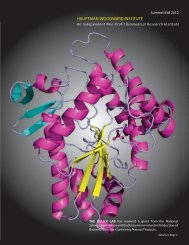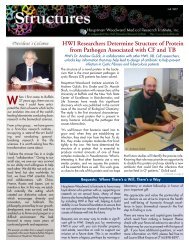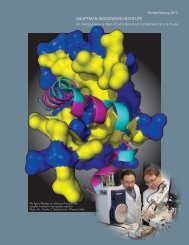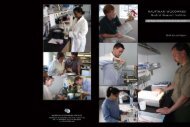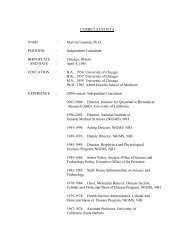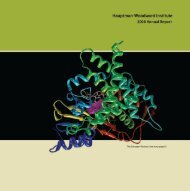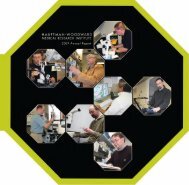Ab Initio Phasing by Dual-Space Direct Methods - Hauptman ...
Ab Initio Phasing by Dual-Space Direct Methods - Hauptman ...
Ab Initio Phasing by Dual-Space Direct Methods - Hauptman ...
Create successful ePaper yourself
Turn your PDF publications into a flip-book with our unique Google optimized e-Paper software.
The solution of the (known) structure of triclinic lysozyme <strong>by</strong> SHELXD and shortly afterwards<strong>by</strong> SnB (Deacon et al., 1998) finally broke the 1000-atom barrier for direct methods (therehappen to be 1001 protein atoms in this structure!). Both programs have also solved a largenumber of previously unsolved structures that had defeated conventional direct methods; someexamples are listed in Table 2. The overall quality of solutions is generally very good, especiallyif appropriate action is taken during the Fourier refinement stage. Two examples are shown inFigure 5.4. DiscussionMost of the time, the Shake-and-Bake method works remarkably well, even for rather largestructures. However, in problematic situations, the user needs to be aware of options that canincrease the chance for success. The following discussion focuses on issues such as gettingbetter initial trial structures, avoiding false minima, using SnB or SHELXD efficiently, andspecial considerations involved in the handling of substructures.4.1. Getting a Better StartWhen slightly heavier atoms such as sulfur are present, it is possible to start the Shake-and-Bakerecycling procedure from a set of atomic positions that are consistent with the PattersonTable 2. Some large structures solved <strong>by</strong> the Shake-and-Bake method. (a) Full structures (>300atoms). (b) Se substructures (>25 Se) solved using peak-wavelength anomalous-difference data.Previously known test data sets are indicated <strong>by</strong> an asterisk (*). When two numbers are given inthe resolution column, the second indicates the lowest resolution at which truncated data haveyielded a solution. The program codes are SnB (S) and SHELXD (D).<strong>Space</strong> Nu Nu Nu(a) Compound Group mol + solv heavy d(Å) Prog. Ref.Vancomycin P4 3 2 1 2 202 258 8Cl 0.9-1.4 S 1312 6Cl 1.09 D 2Actinomycin X2 P1 273 305 --- 0.90 D 3Actinomycin Z3 P2 1 2 1 2 1 186 307 2Cl 0.96 D 4Actinomycin D P1 270 314 --- 0.94 D 4Gramicidin A* P2 1 2 1 2 1 272 317 --- 0.86-1.1 S,D 5DMSO d6 Peptide P1 320 326 --- 1.20 S 6Er-1 Pheromone C2 303 328 7S 1.00 S 7Ristocetin A P2 1 294 420 --- 1.03 D 8Crambin* P2 1 327 423 6S 0.83-1.2 S,D 9,10Hirustasin P4 3 2 1 2 402 467 10S 1.2-1.55 D 11Cyclodex. deriv. P2 1 448 467 --- 0.88 D 12Alpha-1 Peptide P1 408 471 Cl 0.92 S 13Rubredoxin* P2 1 395 497 Fe, 6S 1.0-1.1 S,D 14Vancomycin P1 404 547 12Cl 0.97 S 15BPTI* P2 1 2 1 2 1 453 561 7S 1.08 D 16Cyclodex. deriv. P2 1 504 562 28S 1.00 D 17Balhimycin* P2 1 408 598 8Cl 0.96 D 18Mg-Complex*Scorpion Toxin II*P1P2 1 2 1 2 15765086086248Mg8S0.870.96-1.2DS1920Amylose-CA26 P1 624 771 --- 1.10 D 21Mersacidin P3 2 750 826 24S 1.04 D 22Cv HiPIP H42Q* P2 1 2 1 2 1 631 837 4Fe 0.93 D 23HEW Lysozyme* P1 1001 1295 10S 0.85 S,D 24,25rc-WT Cv HiPIP P2 1 2 1 2 1 1264 1599 8Fe 1.20 D 23Cytochrome c3 P3 1 2024 2208 8Fe 1.20 D 26




